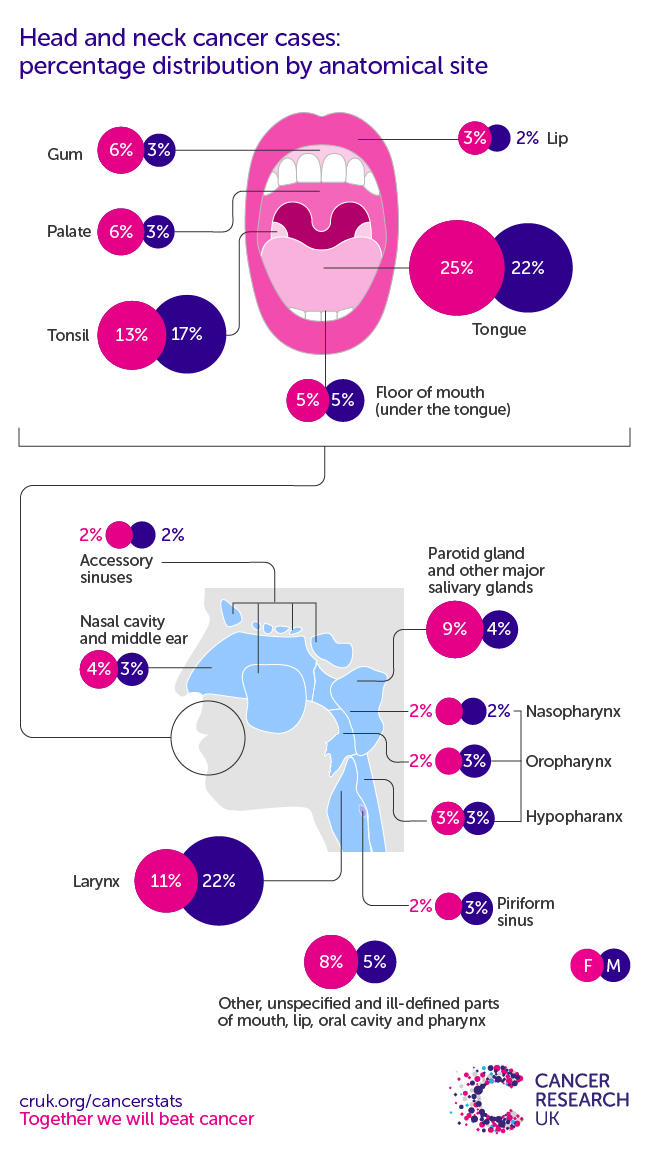Head and neck cancer is the 8th most common cancer in the UK, accounting for 3% of all new cancer cases (2017-2019).[1-4]
In females in the UK, head and neck cancer is the 13th most common cancer (2% of all new female cancer cases). In males in the UK, it is the 5th most common cancer (4% of all new male cancer cases).
31% of head and neck cancer cases in the UK are in females, and 69% are in males.
Head and neck cancer incidence rates (European age-standardised  ) for persons are significantly higher than the UK average in Scotland and Wales and Northern Ireland and significantly lower than the UK average in England.
) for persons are significantly higher than the UK average in Scotland and Wales and Northern Ireland and significantly lower than the UK average in England.
For head and neck cancer, like most cancer types, differences between countries largely reflect risk factor prevalence in years past.
Head and Neck Cancer (C00-C14, C30-C32), Average Number of New Cases Per Year, Crude and European Age-Standardised (AS) Incidence Rates per 100,000 Population, UK, 2017-2019
| England | Scotland | Wales | Northern Ireland | UK | ||
|---|---|---|---|---|---|---|
| Female | Cases | 3,248 | 389 | 219 | 118 | 3,975 |
| Crude Rate | 11.5 | 13.9 | 13.8 | 12.3 | 11.8 | |
| AS Rate | 11.7 | 13.4 | 12.9 | 13.2 | 11.9 | |
| AS Rate - 95% LCL | 11.4 | 12.7 | 11.9 | 11.9 | 11.7 | |
| AS Rate - 95% UCL | 11.9 | 14.2 | 13.9 | 14.6 | 12.1 | |
| Male | Cases | 7,102 | 909 | 520 | 253 | 8,784 |
| Crude Rate | 25.7 | 34.3 | 33.6 | 27.3 | 26.8 | |
| AS Rate | 28.3 | 35.8 | 33.7 | 31.8 | 29.3 | |
| AS Rate - 95% LCL | 27.9 | 34.4 | 32.0 | 29.5 | 28.9 | |
| AS Rate - 95% UCL | 28.6 | 37.1 | 35.4 | 34.1 | 29.6 | |
| Persons | Cases | 10,350 | 1,299 | 739 | 371 | 12,759 |
| Crude Rate | 18.5 | 23.9 | 23.6 | 19.7 | 19.2 | |
| AS Rate | 19.6 | 23.9 | 22.8 | 22.0 | 20.2 | |
| AS Rate - 95% LCL | 19.4 | 23.1 | 21.9 | 20.7 | 20.0 | |
| AS Rate - 95% UCL | 19.8 | 24.6 | 23.8 | 23.2 | 20.4 | |

References
-
England data were provided by the National Cancer Registration and Analysis Service (NCRAS), part of the National Disease Registration Service (NDRS) in NHS England, on request through the Office for Data Release, January 2023. Similar data can be found here: https://www.cancerdata.nhs.uk/
-
Northern Ireland data were provided by the Northern Ireland Cancer Registry (NICR) on request, October 2021. Similar data can be found here:http://www.qub.ac.uk/research-centres/nicr/.
-
Welsh data were published by the Welsh Cancer Intelligence and Surveillance Unit (WCISU), Health Intelligence Division, Public Health Wales https://phw.nhs.wales/services-and-teams/welsh-cancer-intelligence-and-surveillance-unit-wcisu/cancer-reporting-tool-official-statistics/ June 2022.
-
Scotland data were provided by the Scottish Cancer Registry, Public Health Scotland (PHS) on request, May 2021. Similar data can be found here: https://publichealthscotland.scot/publications/show-all-releases?id=20468
About this data
Data is for UK, 2017-2019, ICD-10 C00-C14, C30-C32.










